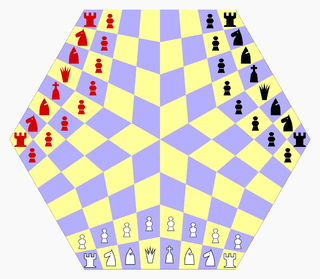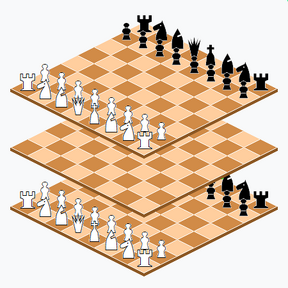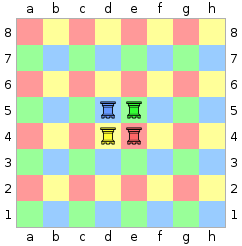
Three-dimensional chess is any chess variant that replaces the two-dimensional board with a three-dimensional array of cells between which the pieces can move. In practical play, this is usually achieved by boards representing different layers being laid out next to each other.

Chaturanga is an ancient Indian strategy game. While there is some uncertainty, the prevailing view among chess historians is that it is the common ancestor of the board games chess (European), xiangqi (Chinese), janggi (Korean), shogi (Japanese), sittuyin (Burmese), makruk (Thai), and modern Indian chess.
Grand Chess is a large-board chess variant invented by Dutch games designer Christian Freeling in 1984. It is played on a 10×10 board, with each side having two additional pawns and two new pieces: the marshal and the cardinal.
A fairy chess piece, variant chess piece, unorthodox chess piece, or heterodox chess piece is a chess piece not used in conventional chess but incorporated into certain chess variants and some chess problems. Compared to conventional pieces, fairy pieces vary mostly in the way they move, but they may also follow special rules for capturing, promotions, etc. Because of the distributed and uncoordinated nature of unorthodox chess development, the same piece can have different names, and different pieces can have the same name in various contexts. Most are symbolised as inverted or rotated icons of the standard pieces in diagrams, and the meanings of these "wildcards" must be defined in each context separately. Pieces invented for use in chess variants rather than problems sometimes instead have special icons designed for them, but with some exceptions, many of these are not used beyond the individual games for which they were invented.
Fairy chess is the area of chess composition in which there are some changes to the rules of chess. The term was introduced by Henry Tate in 1914. Thomas R. Dawson (1889–1951), the "father of fairy chess", invented many fairy pieces and new conditions. He was also problem editor of Fairy Chess Review (1930–1951).
Tamerlane chess is a medieval chess variant. Like modern chess, it is derived from shatranj. It was developed in Central Asia during the reign of Emperor Timur, and its invention is also attributed to him. Because Tamerlane chess is a larger variant of chaturanga, it is also called Shatranj Al-Kabir, as opposed to Shatranj ash-shaghir. Although the game is similar to modern chess, it is distinctive in that there are varieties of pawn, each of which promotes in its own way.

The empress is a fairy chess piece that can move like a rook or a knight. It cannot jump over other pieces when moving as a rook but may do so when moving as a knight. The piece has acquired many names and is frequently called chancellor or marshal.
The grasshopper is a fairy chess piece that moves along ranks, files, and diagonals but only by hopping over another piece. The piece to be hopped may be any distance away, but the grasshopper must land on the square immediately behind it in the same direction. If there is no piece to hop over, it cannot move. If the square beyond a piece is occupied by a piece of the opposite color, the grasshopper can capture that piece. The grasshopper may jump over pieces of either color; the piece being jumped over is unaffected.
Chess with different armies is a chess variant invented by Ralph Betza in 1979. Two sides use different sets of fairy pieces. There are several armies of equal strength to choose from, including the standard FIDE army. In all armies, kings and pawns are the same as in FIDE chess, but the four other pieces are different.
Three-player chess is a family of chess variants specially designed for three players. Many variations of three-player chess have been devised. They usually use a non-standard board, for example, a hexagonal or three-sided board that connects the center cells in a special way. The three armies are differentiated usually by color.

Cubic chess is a chess variant invented by Vladimír Pribylinec beginning with an early version in 1977. The game substitutes cubes for the chess pieces, where four of the faces of each cube display a different chess piece, the two other faces are blank and are orientated to the players. This provides an efficient means to change a piece's type. Kings and queens have unique cubes containing only their symbol, effectively behaving as normal.
Ferdinand Maack (1861–1930) was a German doctor, inventor and occultist. He invented Raumschach, the classic 3D chess game, first described by him in the Frankfurter Zeitung in 1907. He promoted the game with demonstrations, articles, specialist magazines and several books. He founded the Hamburg Raumschach Club in 1919, which remained active until World War II.

Wolf chess is a chess variant invented by Dr. Arno von Wilpert in 1943. It is played on an 8×10 chessboard and employs several fairy pieces including wolf and fox – compound pieces popular in chess variants and known by different names.
The wazir or vazir(word used for describing Queen in Indian chess) is a fairy chess piece that may move a single square vertically or horizontally. In notation, it is given the symbol W. In this article, the wazir is represented by an inverted rook.

Three-man chess is a chess variant for three players invented by George R. Dekle Sr. in 1984. The game is played on a hexagonal board comprising 96 quadrilateral cells. Each player controls a standard army of chess pieces.

The alfil, alpil, or elephant is a fairy chess piece that can jump two squares diagonally. It first appeared in shatranj. It is used in many historical and regional chess variants. It was used in standard chess before being replaced by the bishop in the 15th and 16th centuries.

Parallel worlds chess is a three-dimensional chess variant invented by R. Wayne Schmittberger in the 1980s. The gamespace comprises three 8×8 chessboards at different levels. Each side commands two full chess armies on levels 1 and 3. Level 2 begins empty and obeys its own move rules.

Falcon–hunter chess is a chess variant invented by Karl Schultz in 1943, employing the two fairy chess pieces falcon and hunter. The game takes several forms, including variations hunter chess and decimal falcon–hunter chess added in the 1950s.
Chakra is a chess variant invented by Christian Freeling in 1980. The uniqueness of Chakra is owed to the invention of a new fairy piece named transmitter. Freeling considered an earlier version of the game as insignificant. "Then one night in the early eighties, Ed [van Zon] and I dreamed up the 'transmitter', a piece consisting of two parts called 'chakras', that would function as a 'portal' for transmitting pieces."

A chess variant is a game related to, derived from, or inspired by chess. Such variants can differ from chess in many different ways.











